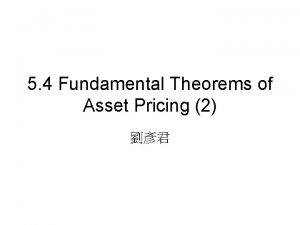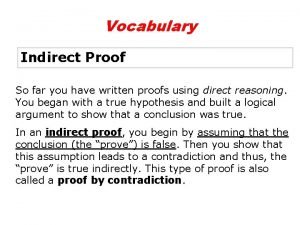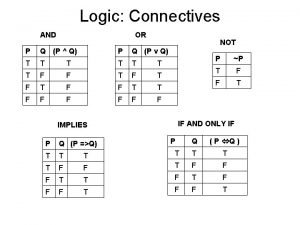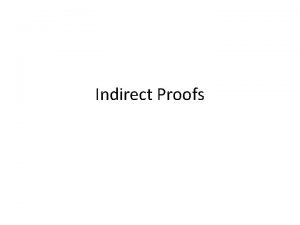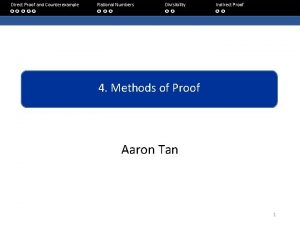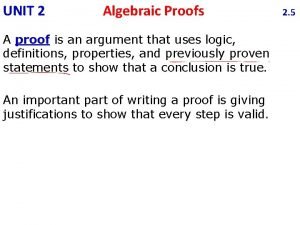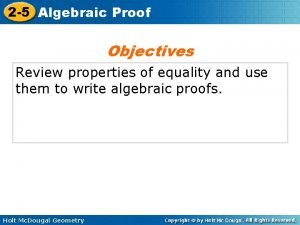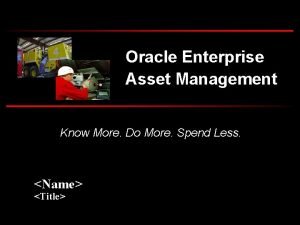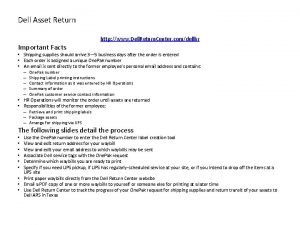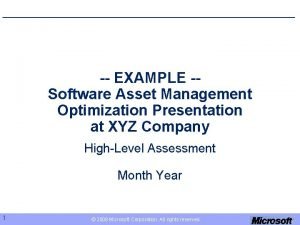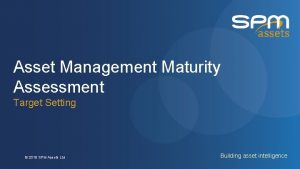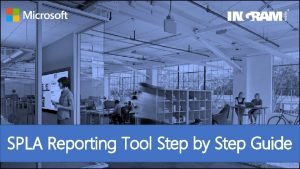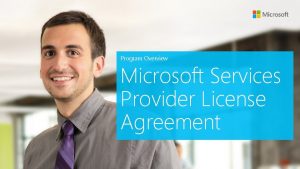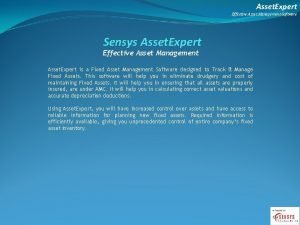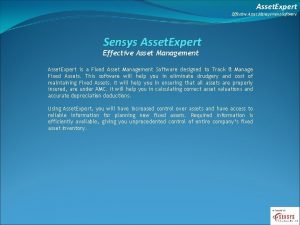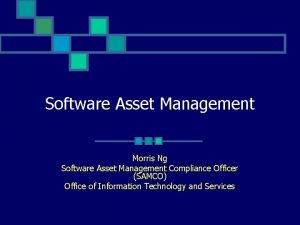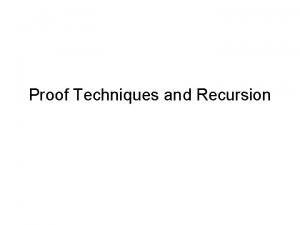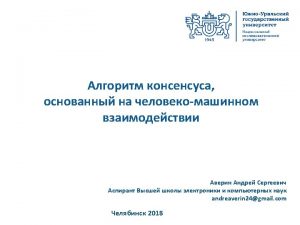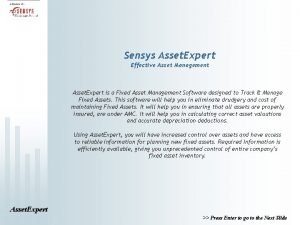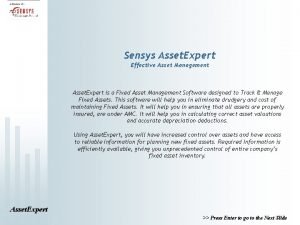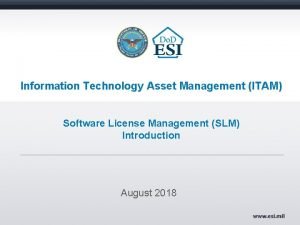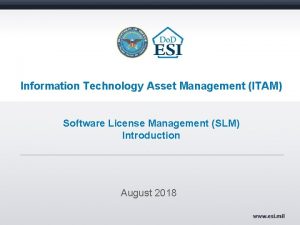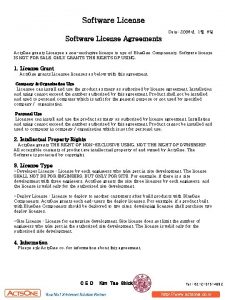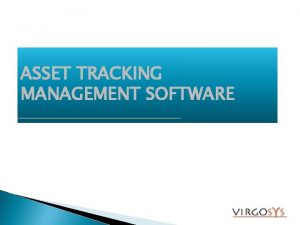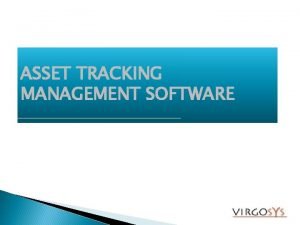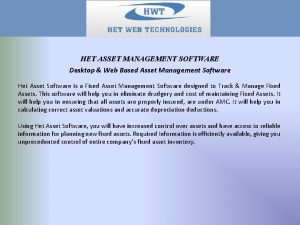Software Asset Management Proof of License for Microsoft

















- Slides: 17

Software Asset Management Proof of License for Microsoft Software

Proof of License for Microsoft Software Who should read this brief: CIOs, IT professionals, software asset managers, IT asset managers, SAM consultants, and IT procurement managers. What it’s about: The various documents you need in order to provide valid proof of license for Microsoft® software. Why you should care: Keeping your proofs of license current is an important part of your licensing agreements with Microsoft.

Proof of License Summary Maintaining proper proof of license is a legal responsibility your organization agrees to whenever it licenses software from Microsoft. Proofs of license consist of certain types of documentation and ensure that all Microsoftware is genuine, has been purchased legitimately, is correctly licensed, and is eligible for all upgrades and support its users are entitled to. Microsoft’s Software Asset Management (SAM) program encourages your organization to meet its proof of license (POL) obligations as stated in its software license agreements with Microsoft. To help you keep your proof of license documents current, the ISO/IEC 19770 -1: 2006 standard recommends that each quarter you review your software inventory and reconcile any difference between the Microsoftware your organization is entitled to use and what it has actually installed.

How Discrepancies Occur The ability to demonstrate POL is in your company’s best interest on several levels. To begin with, POL ensures that your company is using only genuine Microsoftware. Unauthorized software can contain viruses that may potentially damage individual computers and entire networks, while exposing critical company and customer data to risk. Additionally, unauthorized software or licenses that cannot be verified can render software ineligible for product upgrades and Microsoft technical support, diminishing the value of software to your organization. And finally, maintaining proofs of license provides peace of mind by ensuring that your organization is meeting all legal responsibilities when it comes to the use and deployment of Microsoftware. Should your organization ever need to produce evidence of POL, having current proofs of license on hand will save you valuable time with minimal disruption to your core business activities.

Why Maintain Proof of License The vast majority of POL discrepancies are inadvertent. To stay competitive, companies are under constant pressure to deliver the latest software capabilities to their employees. Mergers and acquisitions add further complications to asset management tasks. As a result, it can be difficult to stay on top of how many times a particular software title has been installed, which versions of software eligible for which upgrades, or even where various licensing documents can be found. As a result, POL issues can emerge. Microsoft provides software asset management tools such as Microsoft System Center Configuration Manager and Microsoft Asset Inventory Service, which offer details and comprehensive reports on the software licenses your organization has purchased and software installations in your network environment. (Information on these and other helpful tools is available in the Additional Resources section of this brief). However, ultimately it is your organization’s responsibility to organize your POL documentation and ensure that you can match the licenses you’ve purchased with the ones you’re actually using.

Proof of License Documentation STANDARD LICENSE TERMS (SLT): • Defines the licensing terms related to a particular license and helps organizations understand the rights they have under that license. The SLT documentation applies to full packaged product (FPP), electronic software download (ESD), and original equipment manufacturer (OEM) software. For operating system software, the SLT is an electronic document installed on the computer during software installation. For other software, the SLT may be printed and included with the documentation that comes with the hardware. END-USER LICENSE TERMS: • The End-User License Terms are still used for some full packaged software, and software distributed through OEM retailers, but most have been replaced with the Standard License Terms (SLT) document. VOLUME LICENSING AGREEMENT: For customers buying through such programs as Open, Select Plus, and Enterprise Agreement. Volume Licenses (VLs) typically include a Master Business Agreement or a Master Business and Services Agreement, as well as: • • Product Use Rights (PUR): The PUR is a vital legal document and part of your Microsoft Volume Licensing agreement. It details specific use rights for all software contained in a Volume Licensing program, and provides the use rights for software when a customer acquires a specific license. The PUR is updated quarterly, and should be referenced in conjunction with the Product List: Updated monthly, it provides information for specific products, associated VL programs, migration and upgrade paths, Software Assurance benefits, and other important product details for Microsoftware and Online Services licensed through Microsoft Volume Licensing. It is an addendum to the agreement and is part of the legal documentation.

Proof of License Documentation CERTIFICATE OF AUTHENTICITY (COA): • Consists of a sticker, affixed to the packaging or to the computer in the case of preinstalled Microsoftware, which contains a software product’s key code and verifies that the software media (e. g. , a CD) is a genuine Microsoft product. Not all licenses come with a COA (see below for more details). PROOF OF PURCHASE: • Typically consists of a paid invoice or receipt in either an electronic or physical form. It specifies the software title and the corresponding number of licenses purchased, and provides proof that your organization bought the licensed software from Microsoft or an authorized reseller and that the software license was paid for. • Proof of purchase is also required for all qualifying software—the original base licenses needed in order for upgrade licenses to be considered valid. • For POL purposes, organizations can ask their large account resellers for a purchase report documenting software titles and their corresponding license quantities.

Documentation Requirements by License Type VOLUME LICENSES Software obtained through a volume licensing program typically doesn’t automatically come with manuals, hard copy licenses, or media. The licenses are typically in soft copy or recorded on an online database where you can access your information. It is also important to note that the Microsoft Volume Licensing programs do not provide the initial full version of Windows, but only an upgrade that requires that a full version already be licensed on the PC. LICENSE LIFE SPAN Software licenses offered through the different Microsoft Volume Licensing programs can have different life spans. They can be either perpetual or non-perpetual: • Perpetual licenses are everlasting and valid if the software is being used in accordance with the license agreement requirements. • Non-perpetual licenses, or subscription licenses, are temporary and provide the right to use a particular licensed product until the end of the license-agreement term. They are available only through certain comprehensive Microsoft Volume Licensing programs. Microsoft’s Volume Licenses cover software purchased through a number of volume licensing programs, such as Online Subscription, Open License, Select Plus, Enterprise Agreement, Enterprise Subscription, School Agreement, Campus Agreement, Open Charity, and Government licensing programs. POL requirements for volume licenses include: • Volume Licensing Agreement: – – • • Product Use Rights (PUR) Product List Proof of Purchase: Valid proof of purchase documentation includes the receipt or invoice for both the underlying qualifying software (typically OEM or retail) and the Volume License purchases. NOTE: You can access summaries of your volume license purchases on Microsoft’s Volume Licensing Service Center website. For more information, please see the Additional Resources section.

Documentation Requirements by License Type ORIGINAL EQUIPMENT MANUFACTURER (OEM) LICENSES OEM licenses cover preinstalled software that comes bundled with hardware purchases. POL requirements for OEM software include: • Standard License Terms • Certificate of Authenticity: – The COA for operating system software is affixed to the body of the computer, unless it was purchased with a non-peripheral component (e. g. , motherboard, memory, CPU, or hard drive). In this case, the COA should be included with the software media, and staff should affix the sticker to the body of the computer on which the operating system is installed. For software other than the operating system, the COA should be included with the documentation and system recovery disc that came with the hardware. • Proof of Purchase: – OEM software can be sold only with “qualifying hardware. ” So in order for the OEM license to be considered valid, the proof of purchase needs to identify both the software and the qualified hardware. NOTE: The requirements for qualifying hardware vary based on the type of software. For example: – If the OEM license covers a desktop operating system (e. g. , Windows® XP Professional, Windows – Vista®, or Windows 7), the license needs to be purchased with a non-peripheral hardware component, such as a motherboard, memory, CPU, hard drive, and so on. If the license covers an OEM version of Microsoft Office or Windows Server® (e. g. , Windows 2000 Server, Windows Server 2003, or Windows Server 2008 R 2), only a fully configured computer system is considered qualifying hardware. In other words, valid OEM versions of Microsoft Office or Windows Server are not available alone or with non-peripheral hardware.

Documentation Requirements by License Type FULL PACKAGED PRODUCT LICENSES Full packaged product (FPP) refers to software sold as boxed software in the retail channel. A full packaged product includes the box, software media (e. g. , a CD), and documentation. POL requirements for full packaged products include: • Standard License Terms • Certificate of Authenticity: – For POL purposes, organizations need to retain only the panel with the COA sticker, not the entire box. • Proof of Purchase: – Because full packaged products allow for a one-time transfer of the license, the End-User License Agreement is also required to verify that the license has not been resold, donated, or otherwise transferred to another entity.

Documentation Requirements by License Type ELECTRONIC SOFTWARE DISTRIBUTION LICENSES Electronic software distribution (ESD) licenses cover software that was purchased online and downloaded electronically. POL requirements for ESD software include: • Standard License Terms • Product Use Rights (PUR) • Proof of Purchase: – Typically with ESD licenses, the proof of purchase comes in an email from the company that sold the software from its website. Many resellers of Microsoftware, as well as Microsoft’s own online store, also maintain a record of the sale under the purchaser’s online user account history. In addition, since electronically distributed software allows for a one-time transfer of the license, the End-User License Terms are also required to verify that the license has not been resold, donated, or otherwise transferred to another entity.

Documentation Requirements by License Type MSDN SUBSCRIPTIONS MSDN® subscriptions are licensed on a per-user basis, meaning each user of MSDN software requires a MSDN subscription to use the software. MSDN subscriptions are not offered as a “team” subscription, as such there is no sharing of MSDN subscription benefits for multiple users (except when each user has an MSDN subscription). MSDN Licenses can be purchased through a Volume Licensing agreement or through retail channels. POL requirements for MSDN subscriptions include: • Volume Licensing Agreement: – Product Use Rights (PUR): • NOTE: Software obtained through an MSDN subscription may be used only for the purposes of design, development, test, and demonstration of your programs. MSDN software may not be used in production environments, except where noted in the PUR. – Product List • Standard License Terms: For retail customers the license terms are specified in the Retail Software License Terms included with your product. • Proof of Purchase: Proof of purchase should include the named individual to whom the software is assigned. – NOTE: You can access summaries of your volume license purchases on Microsoft’s Volume Licensing Service Center website. For more information, please see the Additional Resources section.

Documentation Requirements by License Type SERVICE PROVIDER LICENSE AGREEMENTS Licenses purchased through a Service Provider License Agreement (SPLA) or a SPLA Essential cover monthly usage only and are not perpetual. Customers purchase SPLAs through an authorized service provider and pay for them at the end of the month based on monthly usage reports provided by the SPLA service provider. POL requirements for SPLAs include: • Volume Licensing Agreement: – Services Provider Product Use Rights (SPUR): The standard license terms for SPLA is defined in the SPUR, an electronic document available on the Microsoft Volume Licensing website. • – • NOTE: With SPLA v 2009, Rental Rights were removed from SPLA and are now a separate license (see “Rental Rights Licenses” below). Product list Proof of Purchase: – For SPLA and SPLA Essential licensed software, the monthly usage report, which specifies the title of the software and the corresponding number of licenses used during the previous month, serves as the proof of purchase. For POL purposes, customers may instead use a report provided by their service provider, as long as it shows the title of the software and the corresponding number of licenses on a monthly basis. – NOTE for SPLA Providers: • Per your SPLA agreement, you need to submit either a monthly use report or zero use report to your SPLA reseller (or to Microsoft for direct agreements) on all licenses that were authorized for your customers to use, regardless whether you used any products or provided software services to your customers. You also need to include the end-customer name and address if the customer generated more than U. S. $1, 000 per month in revenue. All reporting records must be maintained for two years from your agreement’s end date. Additionally, for the monthly use report or zero use report, you must also report your affiliates and software services resellers.

Documentation Requirements by License Type RENTAL RIGHTS LICENSES The Rental Rights license program became effective on January 1, 2010, and falls under the Volume Licensing program. Rental Rights do not equate to a full product license, but rather are an add-on license that modifies the right to use qualifying software on a particular device. The license’s Product Use Rights (PUR) or Product List identifies which products are considered qualifying software. Besides adding rights, Rental Rights licenses may also add restrictions. Here’s an example of an additional restriction: “A Rental Rights license is permanently assigned to a specific device and cannot be reassigned to another device. When the device reaches its operational end-of-life (‘dies’), so does the license. ” POL requirements for Rental Rights licenses include: • Volume Licensing Agreement: – Product Use Rights (PUR) – Product List • Proof of Purchase – NOTE: You can access summaries of your volume license purchases on Microsoft’s Volume License Service Center website. For more information, please see the Additional Resources section.

Documentation Requirements by License Type OTHER LICENSE TYPES • Upgrade Licenses: Upgrade licenses are available for Microsoft operating systems and for some, not all, Microsoft Office products. Because an upgrade license is based on an underlying, full software license (e. g. , the original software version), it requires POL documentation for both the upgrade license and underlying software license. That means that in order for an upgrade to be considered valid, documentation for the original version license is required. Additionally, upgrade licenses are offered only as retail FPP and through Volume Licensing. They are not available through OEMs. • Software Assurance Licenses: Software Assurance (SA) licenses provide the use rights for the most current version released during the term of the SA. At the end of that term, the customer is granted the most current license for the product covered by SA. On the Microsoft Volume Licensing Service Center website the upgraded license will appear as a new license, with no reference that it has been acquired through SA. Therefore, in order to be considered valid, POL requires documentation for both the SA license and the license for the underlying software. – NOTE: There are strict time limits for purchasing SA for various software licenses. With OEM licenses, customers have 90 days from the date of purchase to enroll these licenses in SA through a volume licensing agreement. They can do so through a local reseller. Existing VL customers also have 90 days to renew SA coverage from the date existing coverage expires. • Upgrade Advantage Licenses: Upgrade Advantage licenses are full licenses for the latest version of the software available at the time Upgrade Advantage expired. (NOTE: Microsoft ended Upgrade Advantage on July 31, 2002. ) For many organizations, it is possible that a valid OEM, full packaged product, or volume license was enrolled in the Upgrade Advantage program during the term of the license agreement. Since Upgrade Advantage was based on one of these underlying licenses, POL requires documentation for both Upgrade Advantage and the underlying license. • Transferred Licenses: POL requirements vary depending on the type of program used to acquire the first license and the date the license was transferred. To understand POL requirements, organizations should review the transfer clauses in their Volume Licensing Agreement. In addition, they can contact their Microsoft account representative or a Microsoft licensing specialist. Licensing specialists are available by calling (800) 426 -9400, Monday through Friday, 6: 00 A. M. – 5: 30 P. M. Pacific Time.

Volume Licensing Resources for Customers www. microsoft. com/licensing/ has licensing terms, conditions, and supplemental information relevant to using products licensed through Microsoft Volume Licensing programs, where you can find the following: Microsoft Product List: Microsoft Product Use Rights: Volume Licensing Support Documents: Microsoft Technical Limitations: Worldwide Contact Information:

To find out more: www. microsoft. com/sam www. microsoft. com/licensing © 2011 Microsoft Corporation.
 Software asset management microsoft
Software asset management microsoft Fundamental theorem of asset pricing proof
Fundamental theorem of asset pricing proof Direct proof and indirect proof
Direct proof and indirect proof Direct proof and indirect proof
Direct proof and indirect proof Indirect proof examples
Indirect proof examples Direct proof and indirect proof
Direct proof and indirect proof Unit 2 logic and proof homework 6 algebraic proof
Unit 2 logic and proof homework 6 algebraic proof Direct algebraic proof
Direct algebraic proof Roof asset management software
Roof asset management software Oracle enterprise asset management software
Oracle enterprise asset management software Dell ups returns
Dell ups returns Maximo tivoli
Maximo tivoli Local government asset management software
Local government asset management software Software asset management presentation
Software asset management presentation Software asset management maturity model
Software asset management maturity model Managing assets vs asset management
Managing assets vs asset management Spla reporting
Spla reporting Microsoft services provider license agreement
Microsoft services provider license agreement

